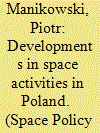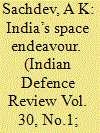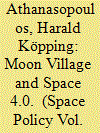| Srl | Item |
| 1 |
ID:
120654


|
|
|
|
|
| Publication |
2013.
|
| Summary/Abstract |
Poland has a long-standing tradition in space activities. Polish institutions have participated as co-investigators in almost all European Space Agency (ESA) science projects, as well as on many other missions. However, the first Polish satellite (PW-SAT) was only launched in 2012. Poland was one of the first Eastern European countries to conclude a Cooperation Agreement with ESA in the peaceful use of outer space; it was signed in 1994 and followed by a second in January 2002. Negotiations on Polish membership in the ESA were started in autumn of 2011, and ended in April 2012. Following ratification of the agreement, Poland officially became the 20th Member State of ESA on 19 November 2012. This article examines how Poland is setting its way as a space nation. It describes recent developments in the Polish space programme, including the road to Poland's full membership in the European Space Agency.
|
|
|
|
|
|
|
|
|
|
|
|
|
|
|
|
| 2 |
ID:
138584


|
|
|
|
|
| Summary/Abstract |
As in the case of the US, for India too, satellite data and its associated connectivity touch every aspect of daily life.
|
|
|
|
|
|
|
|
|
|
|
|
|
|
|
|
| 3 |
ID:
138224


|
|
|
|
|
| Summary/Abstract |
Public engagement (PE) initiatives can lead to a long term public support of science. However most of the real impact of PE initiatives within the context of long-term science policy is not completely understood. An examination of the National Aeronautics and Space Administration's (NASA) and European Space Agency's (ESA) Hubble Space Telescope, James Webb Space Telescope, and NASA's International Sun/Earth Explorer 3 reveal how large grassroots movements led by citizen scientists and space aficionados can have profound effects on public policy. We explore the role and relevance of public grassroots movements in the policy of space astronomy initiatives, present some recent cases which illustrate policy decisions involving broader interest groups, and consider new avenues of PE including crowdfunding and crowdsourcing.
|
|
|
|
|
|
|
|
|
|
|
|
|
|
|
|
| 4 |
ID:
169345


|
|
|
|
|
| Summary/Abstract |
This article discusses the Moon Village concept within the context of the increasing momentum to return human beings to the surface of the Moon. The article follows a dual objective. Firstly, the Moon Village is probably the most misunderstood among the plethora of ideas to explore the Moon scientifically and commercially. The article is therefore intended to explore what the Moon Village actually is. Secondly, the article explores the strengths and weaknesses of the Moon Village. The article is divided into three sections. The first section reviews the current Moon projects of public and private space actors, including the United States, Russia, China, SpaceX and Blue Origin. It sets the scene for the argument that the Moon Village has entered global discourse on space within a positive political environment. The second section discusses the premises of ESA chief Jan Wörner’s Moon Village concept, putting forward that the Moon Village is intended as an open concept rather than as a concrete plan. It is a process rather than a project and it is meant to initiate a global conversation on humanity’s future on the Moon. As such, the world café is an appropriate metaphor to illustrate the idea behind the Moon Village. In the third and final section a SWAT/PEST analysis is conducted to assess the feasibility of the Moon Village, highlighting that one of the major opportunities of the project is to promote international cooperation. The article concludes by supporting the institutionalist hypothesis that the Moon Village is arguably a translation of the ESA system to the global level, as participation is voluntary and as it builds on the strengths of each cooperation partner. As such, the Moon Village in indeed a new way of doing space on the global level.
|
|
|
|
|
|
|
|
|
|
|
|
|
|
|
|